Experimental Investigation of Heat Pipe Inclination Angle Effect on Temperature Nonuniformity in Electrical Machines
Abstract
:1. Introduction
- This paper quantitatively investigates motor temperature nonuniformity due to the HP inclination angle effect through experimentations.
- An improved structure with enlarged fins is proposed to compensate for the degradation of HP thermal performance and improve motor temperature distribution.
- The proposed structure is verified by comparative experiments between original and improved specimens.
2. Experimental Setup
2.1. Specimen Preparation
2.2. Experimental Platform
2.3. Instrumentation and Data Acquisition
3. Experiments and Results
3.1. Data Processing
3.2. Temperature Distribution
3.3. Effect of Current Density
3.4. Effect of Wind Velocity
4. An Improved Structure for More Uniform Temperature Distribution
4.1. Proposed Improved Structure
4.2. Specimens Preparation with Different Fin Areas
4.3. Experiments and Results
5. Experimental Verification
5.1. Temperature Distribution for the Improved Specimen
5.2. Effects of Current Density and Wind Velocity
6. Conclusions
Author Contributions
Funding
Data Availability Statement
Conflicts of Interest
References
- Zhang, F.; Gerada, D.; Xu, Z.; Zhang, X.; Tighe, C.; Zhang, H.; Gerada, C. Back-iron extension thermal benefits for electrical machines with concentrated windings. IEEE Trans. Ind. Electron. 2019, 67, 1728–1738. [Google Scholar] [CrossRef]
- Ramesh, P.; Lenin, N.C. High Power Density Electrical Machines for Electric Vehicles—Comprehensive Review Based on Material Technology. IEEE Trans. Magn. 2019, 55, 1–21. [Google Scholar] [CrossRef]
- Dong, C.; Qian, Y.; Zhang, Y.; Zhuge, W. A Review of Thermal Designs for Improving Power Density in Electrical Machines. IEEE Trans. Transp. Electrif. 2020, 6, 1386–1400. [Google Scholar] [CrossRef]
- Zhang, F.; Gerada, D.; Xu, Z.; Liu, C.; Zhang, H.; Zou, T.; Chong, Y.; Gerada, C. A Thermal Modelling Approach and Experimental Validation for an Oil Spray-Cooled Hairpin Winding Machine. IEEE Trans. Transp. Electrif. 2021, 7, 2914–2926. [Google Scholar] [CrossRef]
- Wu, S.; Tian, C.; Zhang, P.; Huang, X.; Shan, X. Design and Optimization Analysis of Composite Water Cooling System Based On High Power Density Motor. In Proceedings of the 2019 22nd International Conference on Electrical Machines and Systems (ICEMS), Harbin, China, 11–14 August 2019; pp. 1–6. [Google Scholar] [CrossRef]
- Li, L.; Zhang, J.; Zhang, C.; Yu, J. Research on Electromagnetic and Thermal Issue of High-Efficiency and High-Power-Density Outer-Rotor Motor. IEEE Trans. Appl. Supercond. 2016, 26, 1–5. [Google Scholar] [CrossRef]
- Yu, Z.; Li, Y.; Jing, Y.; Wang, J. Cooling System of Outer Rotor SPMSM for a Two-Seater All-Electric Aircraft Based on Heat Pipe Technology. IEEE Trans. Transp. Electrif. 2021, 8, 1656–1664. [Google Scholar] [CrossRef]
- Le, W.; Lin, M.; Lin, K.; Liu, K.; Jia, L.; Yang, A.; Wang, S. A Novel Stator Cooling Structure for Yokeless and Segmented Armature Axial Flux Machine with Heat Pipe. Energies 2021, 14, 5717. [Google Scholar] [CrossRef]
- Geng, W.; Zhu, T.; Li, Q.; Zhang, Z. Windings Indirect Liquid Cooling Method for a Compact Outer-Rotor PM Starter/Generator with Concentrated Windings. IEEE Trans. Energy Convers. 2021, 36, 3282–3293. [Google Scholar] [CrossRef]
- Sun, Y.; Zhang, S.; Chen, G.; Tang, Y.; Liang, F. Experimental and numerical investigation on a novel heat pipe based cooling strategy for permanent magnet synchronous motors. Appl. Therm. Eng. 2020, 170, 114970. [Google Scholar] [CrossRef]
- Fang, G.; Yuan, W.; Yan, Z.; Sun, Y.; Tang, Y. Thermal management integrated with three-dimensional heat pipes for air-cooled permanent magnet synchronous motor. Appl. Therm. Eng. 2019, 152, 594–604. [Google Scholar] [CrossRef]
- Reay, D.; McGlen, R.; Kew, P. Heat Pipes: Theory, Design and Applications; Butterworth-Heinemann: Oxford, UK, 2013. [Google Scholar]
- Faghri, A. Heat Pipes: Review, Opportunities and Challenges. Front. Heat Pipes 2014, 5, 2–4. [Google Scholar] [CrossRef] [Green Version]
- Alammar, A.A.; Al-Dadah, R.K.; Mahmoud, S.M. Numerical investigation of effect of fill ratio and inclination angle on a thermosiphon heat pipe thermal performance. Appl. Therm. Eng. 2016, 108, 1055–1065. [Google Scholar] [CrossRef]
- Hu, M.; Zheng, R.; Pei, G.; Wang, Y.; Li, J.; Ji, J. Experimental study of the effect of inclination angle on the thermal performance of heat pipe photovoltaic/thermal (PV/T) systems with wickless heat pipe and wire-meshed heat pipe. Appl. Therm. Eng. 2016, 106, 651–660. [Google Scholar] [CrossRef] [Green Version]
- Noie, S.; Emami, M.S.; Khoshnoodi, M. Effect of inclination angle and filling ratio on thermal performance of a two-phase closed thermosyphon under normal operating conditions. Heat Transf. Eng. 2007, 28, 365–371. [Google Scholar] [CrossRef]
- Tang, H.; Weng, C.; Tang, Y.; Lu, Y.; Fu, T. Effect of inclination angle on the thermal performance of an ultrathin heat pipe with multi-scale wick structure. Int. Commun. Heat Mass Transf. 2020, 118, 104908. [Google Scholar] [CrossRef]
- Yousefi, T.; Mousavi, S.; Farahbakhsh, B.; Saghir, M. Experimental investigation on the performance of CPU coolers: Effect of heat pipe inclination angle and the use of nanofluids. Microelectron. Reliab. 2013, 53, 1954–1961. [Google Scholar] [CrossRef]
- Zhang, S.; Chen, J.; Sun, Y.; Li, J.; Zeng, J.; Yuan, W.; Tang, Y. Experimental study on the thermal performance of a novel ultra-thin aluminum flat heat pipe. Renew. Energy 2019, 135, 1133–1143. [Google Scholar] [CrossRef]
- Hossein, K.; Toghraie, D. A comprehensive study of the performance of a heat pipe by using of various nanofluids. Adv. Powder Technol. 2017, 28, 3074–3084. [Google Scholar]
- Jin, K.; Tai, Y.; Toghraie, D.; Hekmatifar, M. The effects of nanoparticle percentages and an external variable magnetic field on the atomic and thermal behaviors in an oscillating heat pipe via molecular dynamics simulation. J. Mol. Liq. 2022, 360, 119570. [Google Scholar] [CrossRef]
- Mostafazadeh, A.; Toghraie, D.; Mashayekhi, R.; Akbari, O.A. Effect of radiation on laminar natural convection of nanofluid in a vertical channel with single- and two- phase approaches. J. Therm. Anal. Calorim. 2019, 138, 779–794. [Google Scholar] [CrossRef]
- Zhang, X.; Zhang, C.; Fu, P.; Zhang, C.; Li, L. A Novel Cooling Technique for the Windings of High-Torque-Density Permanent Magnet Machines. In Proceedings of the 2018 21st International Conference on Electrical Machines and Systems (ICEMS), Jeju, Republic of Korea, 7–10 October 2018; pp. 332–337. [Google Scholar] [CrossRef]
- Putra, N.; Ariantara, B. Electric motor thermal management system using L-shaped flat heat pipes. Appl. Therm. Eng. 2017, 126, 1156–1163. [Google Scholar] [CrossRef]
- Gai, Y.; Kimiabeigi, M.; Chong, Y.; Widmer, J.D.; Deng, X.; Popescu, M.; Goss, J.; Staton, D.A.; Steven, A. Cooling of Automotive Traction Motors: Schemes, Examples, and Computation Methods. IEEE Trans. Ind. Electron. 2019, 66, 1681–1692. [Google Scholar] [CrossRef]
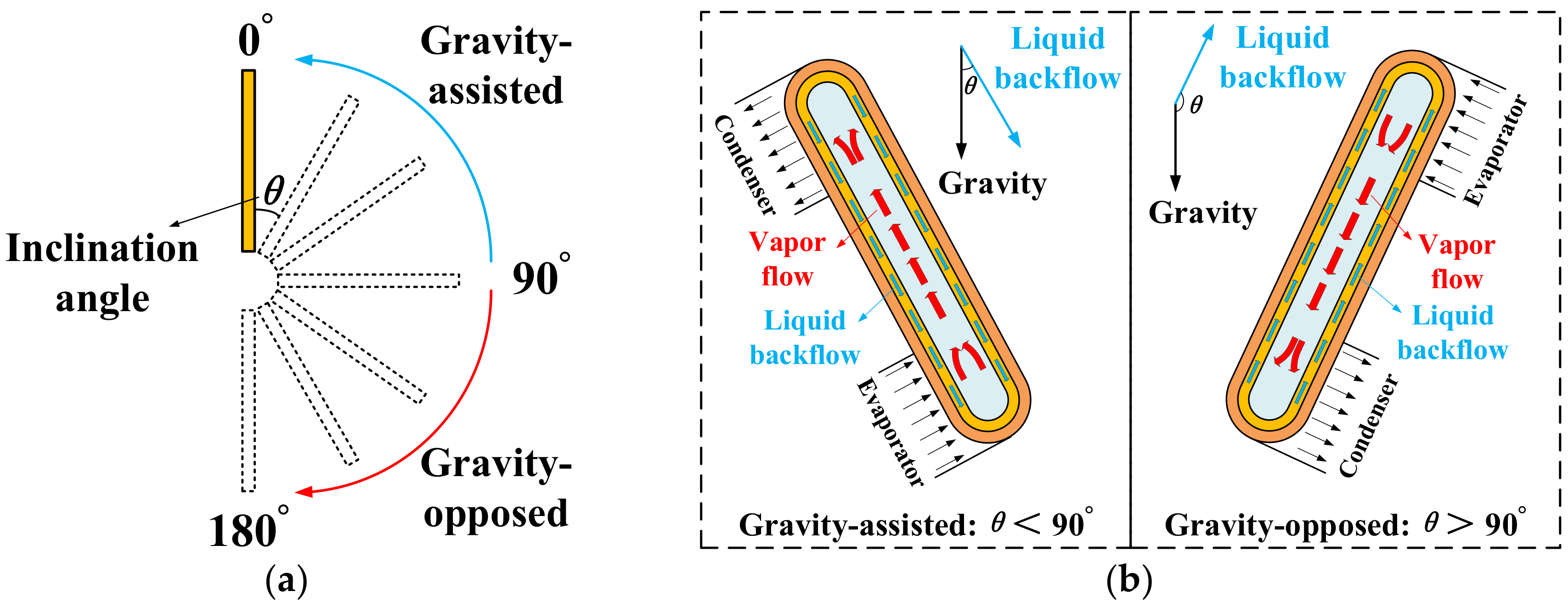



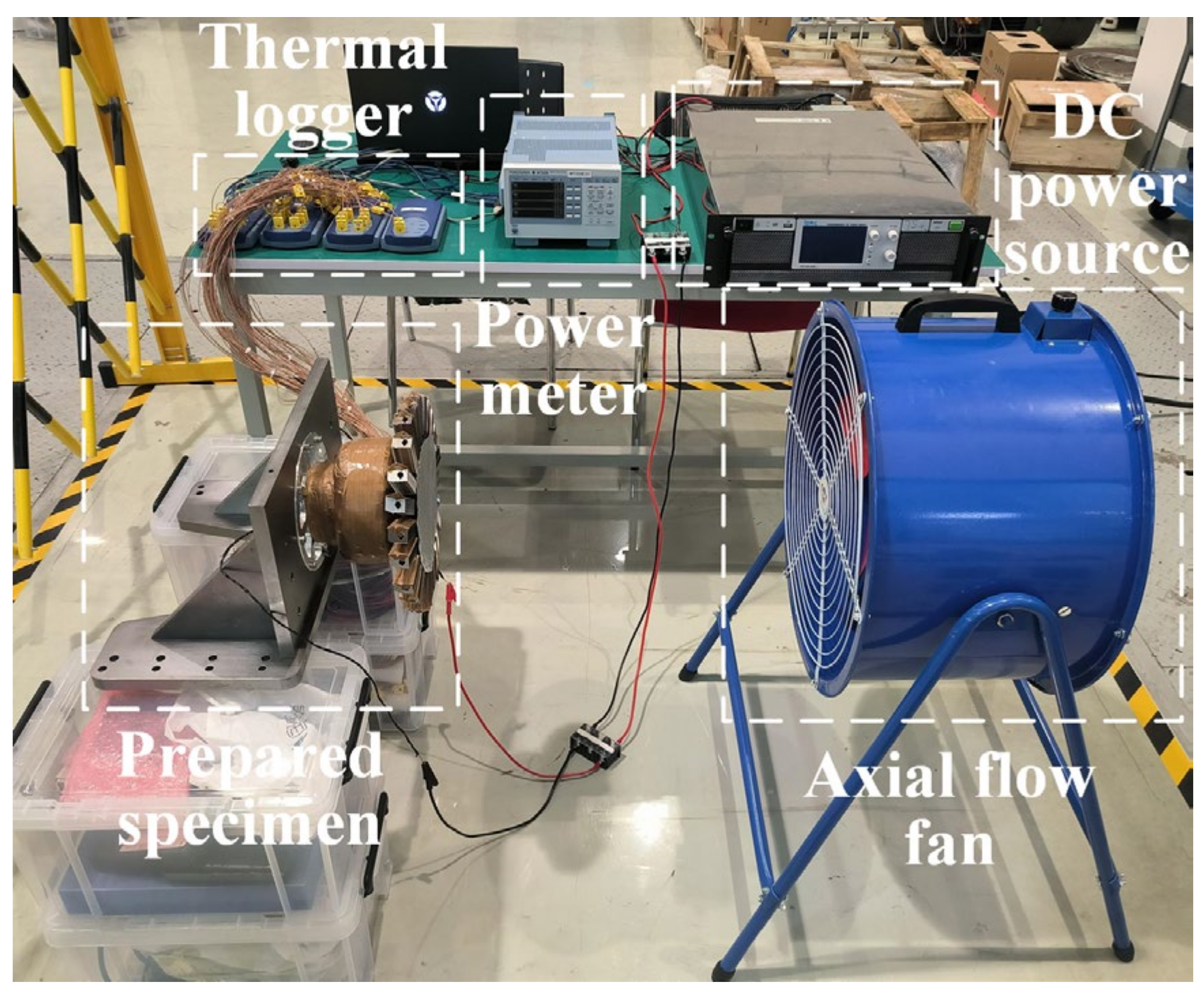

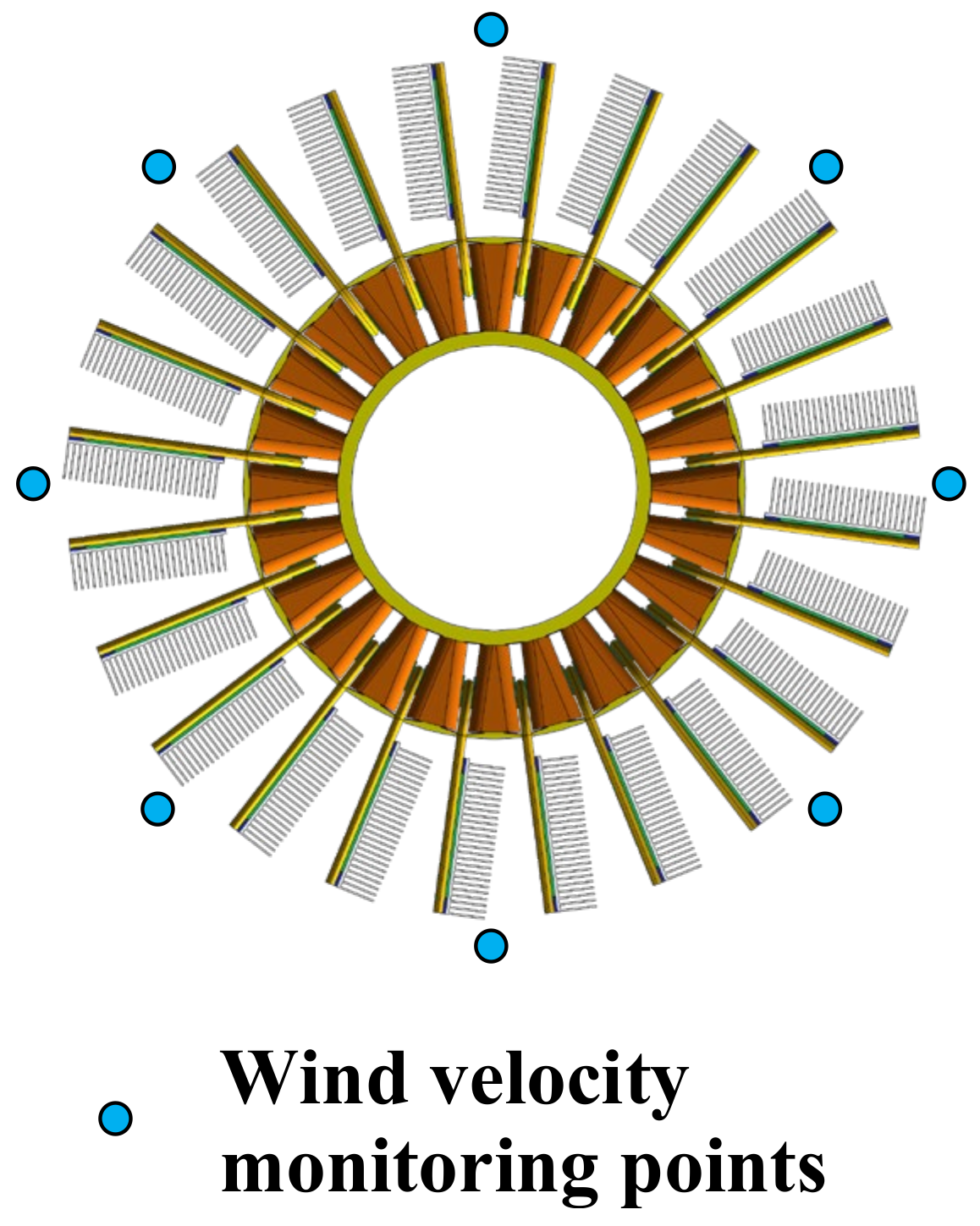


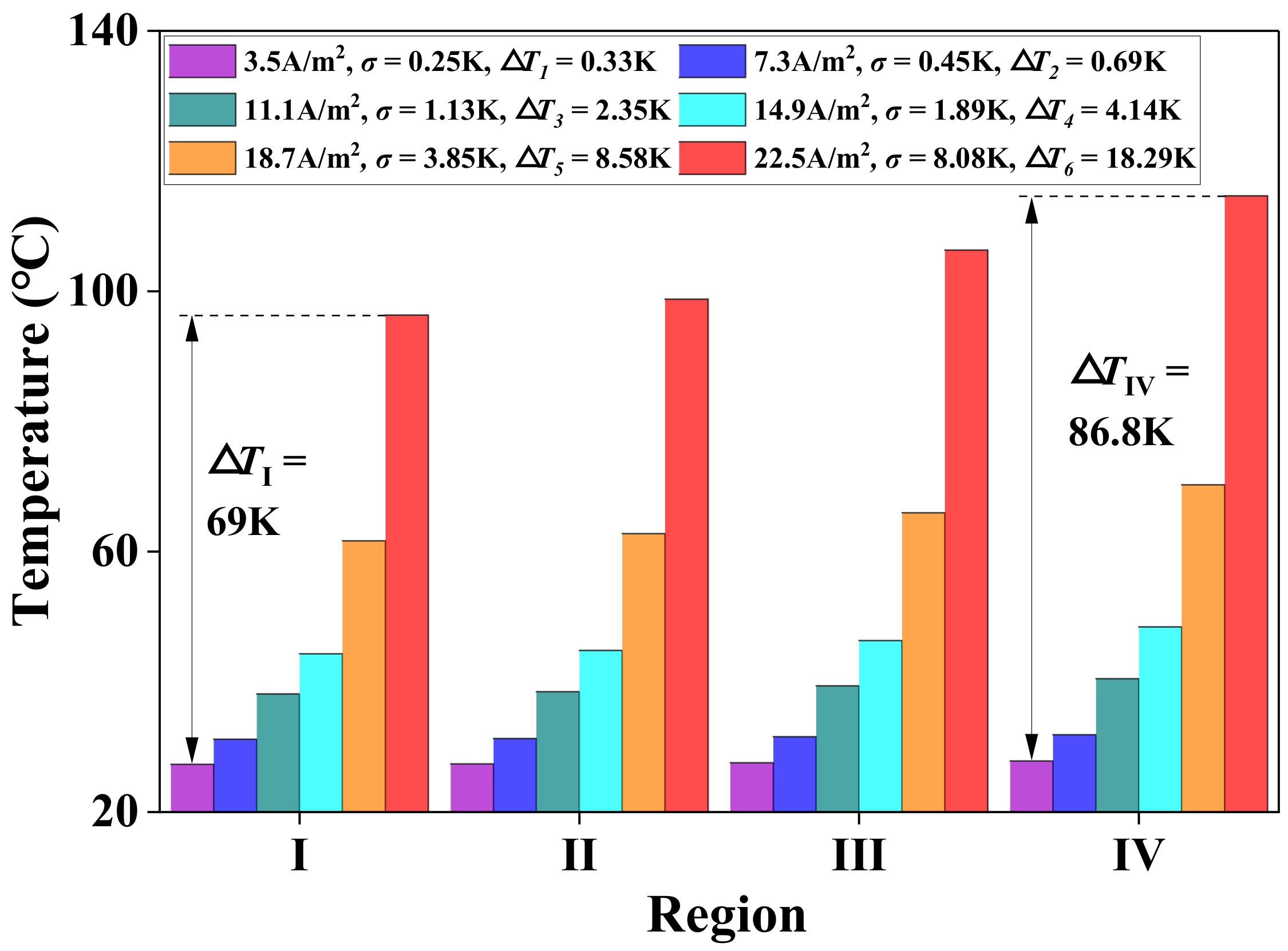
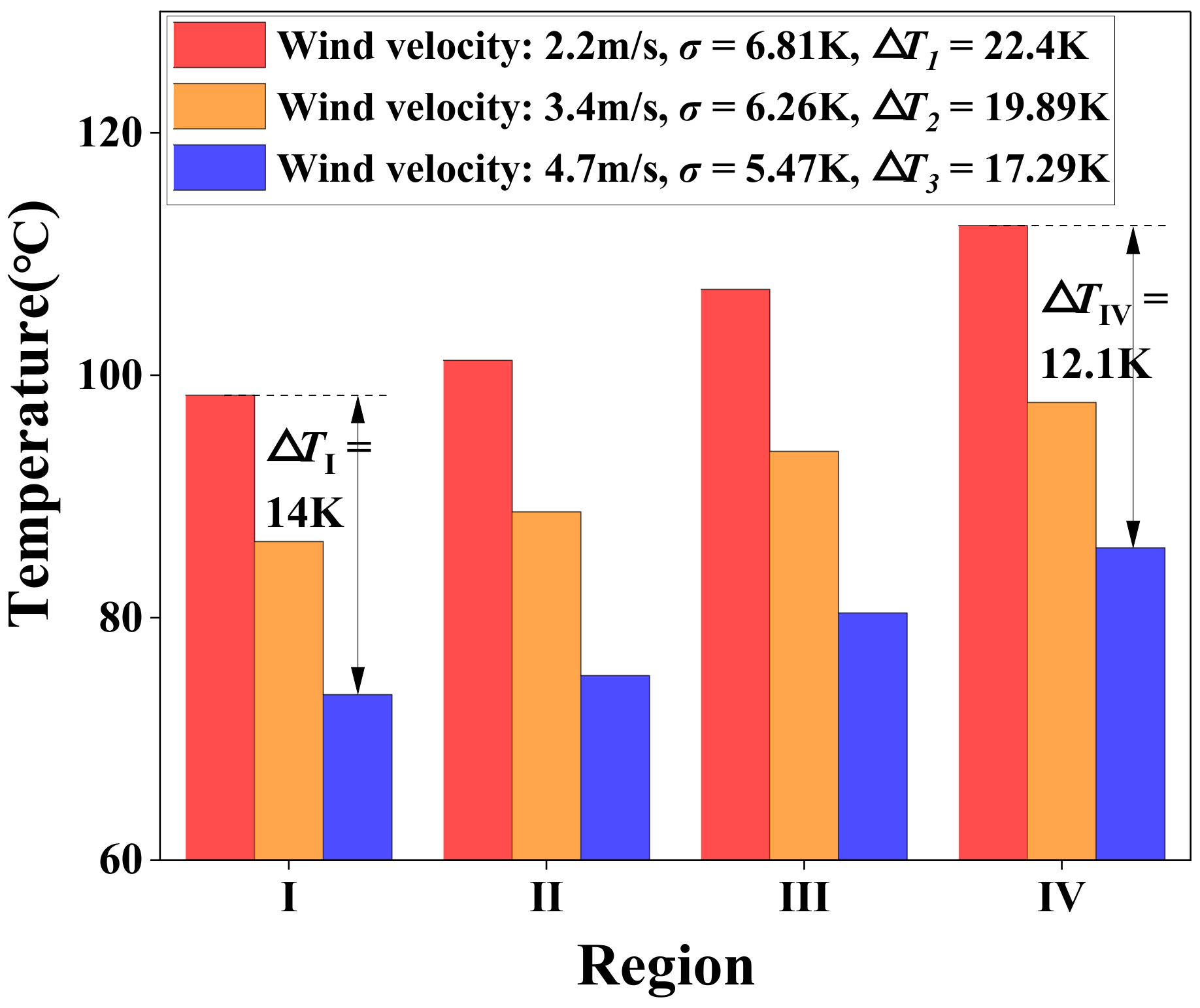

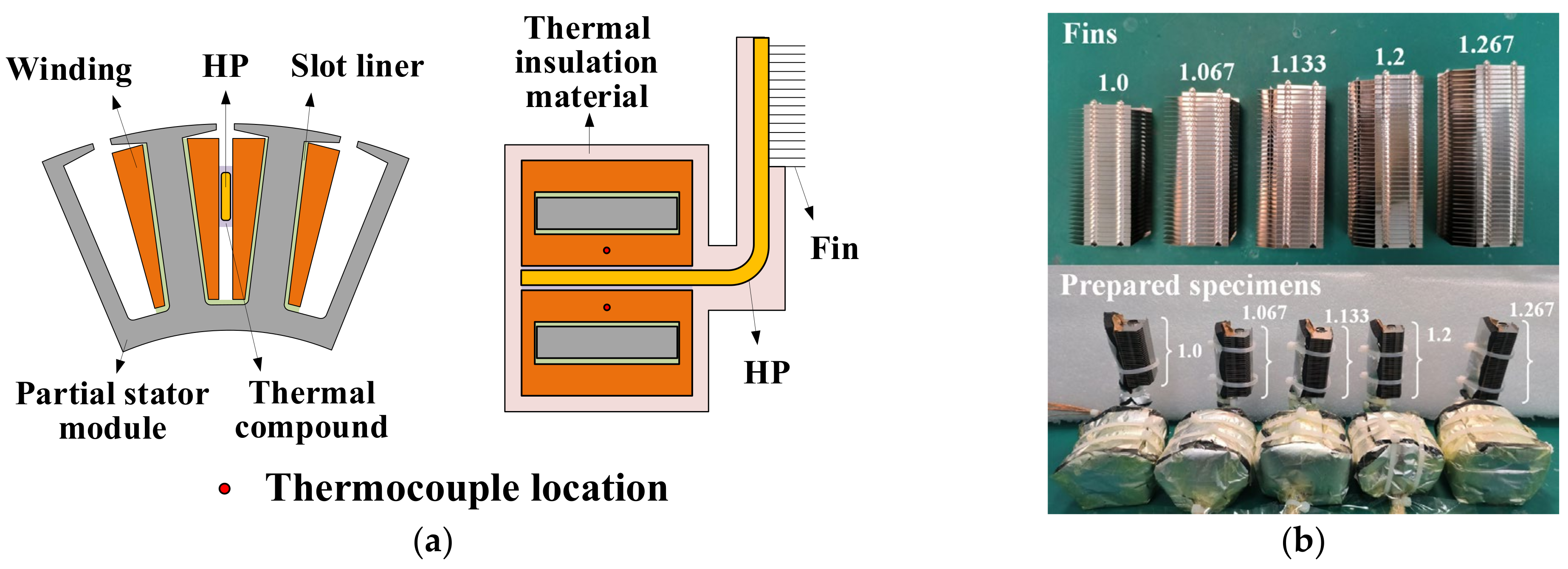

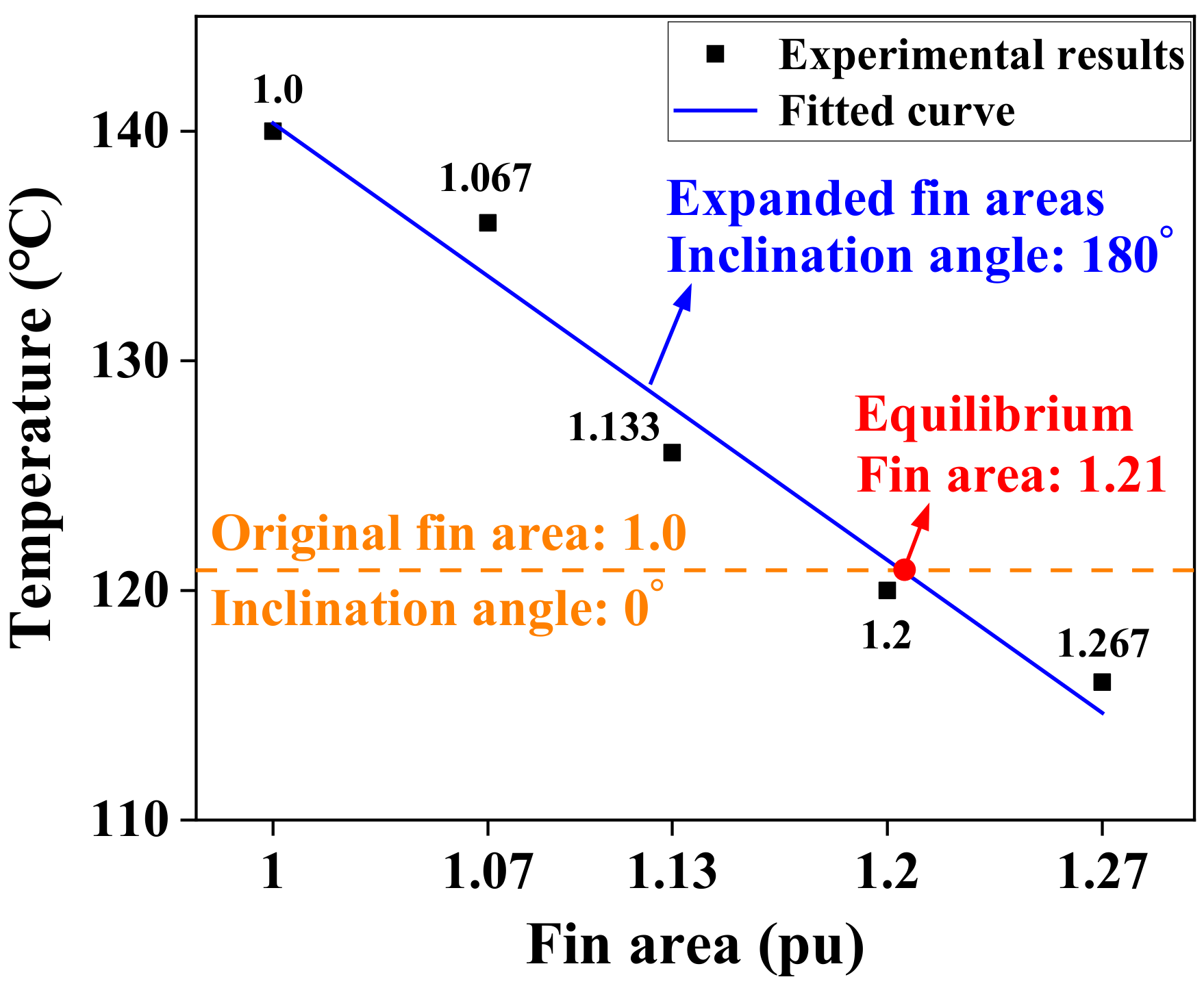




| Parameters | Value |
|---|---|
| Length | 170 mm |
| Width | 8 mm |
| Thickness | 3 mm |
| Material | Copper |
| Working medium | Water |
| Interior structure | Sintered wick structure |
| Division | HP Number | Inclination Angle Range |
|---|---|---|
| Region I | 1, 2, 3, 22, 23, 24 | 0–45° |
| Region II | 4, 5, 6, 19, 20, 21 | 45–90° |
| Region III | 7, 8, 9, 16, 17, 18 | 90–135° |
| Region IV | 10, 11, 12, 13, 14, 15 | 135–180° |
| Specimen | No. of Fin Arrays | Fin Area (pu) | Inclination Angle during Test |
|---|---|---|---|
| Original | 15 | 1.0 | 0° and 180° |
| Option 1 | 16 | 1.067 | 180° |
| Option 2 | 17 | 1.133 | 180° |
| Option 3 | 18 | 1.2 | 180° |
| Option 4 | 19 | 1.267 | 180° |
Disclaimer/Publisher’s Note: The statements, opinions and data contained in all publications are solely those of the individual author(s) and contributor(s) and not of MDPI and/or the editor(s). MDPI and/or the editor(s) disclaim responsibility for any injury to people or property resulting from any ideas, methods, instructions or products referred to in the content. |
© 2022 by the authors. Licensee MDPI, Basel, Switzerland. This article is an open access article distributed under the terms and conditions of the Creative Commons Attribution (CC BY) license (https://creativecommons.org/licenses/by/4.0/).
Share and Cite
Zhang, X.; Zhao, H.; Li, J.; Zhang, F.; Zhang, Y.; Yan, H.; Niu, Z.; Gerada, D.; Zhang, H. Experimental Investigation of Heat Pipe Inclination Angle Effect on Temperature Nonuniformity in Electrical Machines. Energies 2023, 16, 350. https://doi.org/10.3390/en16010350
Zhang X, Zhao H, Li J, Zhang F, Zhang Y, Yan H, Niu Z, Gerada D, Zhang H. Experimental Investigation of Heat Pipe Inclination Angle Effect on Temperature Nonuniformity in Electrical Machines. Energies. 2023; 16(1):350. https://doi.org/10.3390/en16010350
Chicago/Turabian StyleZhang, Xiaochen, Han Zhao, Jing Li, Fengyu Zhang, Yue Zhang, Hongyu Yan, Zhihao Niu, David Gerada, and He Zhang. 2023. "Experimental Investigation of Heat Pipe Inclination Angle Effect on Temperature Nonuniformity in Electrical Machines" Energies 16, no. 1: 350. https://doi.org/10.3390/en16010350





